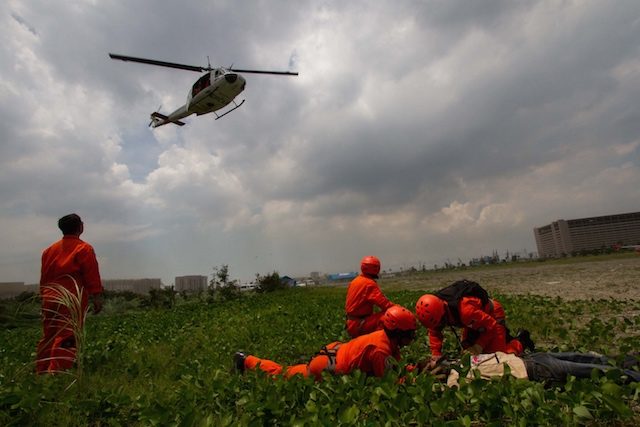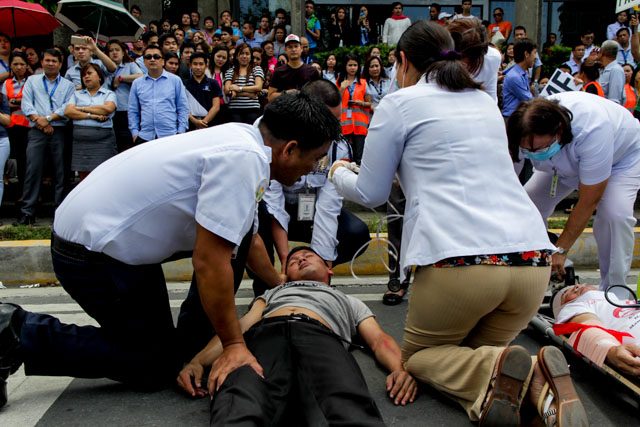SUMMARY
This is AI generated summarization, which may have errors. For context, always refer to the full article.

MANILA, Philippines – International observers called Metro Manila’s first-ever metrowide earthquake drill on Thursday, July 30, a good first attempt, with all 17 local government units participating in the massive simulation of how disaster officials should respond in the event of a powerful quake striking the metropolis.
Mark Bidder, head of the United Nations Office for the Coordination of Humanitarian Affairs (UN OCHA), said the drill was a “chance for responders to come together, to coordinate their actions, and work out problems they can face.”
The metrowide drill, which took around two months to plan, aimed to raise awareness on what to do in the event of a powerful quake – called the “Big One” by experts, or a 7.2-magnitude earthquake that could hit Metro Manila when the West Valley Fault moves. (READ: 57 subdivisions, villages traversed by West Valley Fault)
Starting at 10:30 am, Thursday, Metro Manila residents were asked to perform the “duck, cover, and hold safety routine” for 45 seconds as a siren signaled the start of the event.
Various scenarios were staged at the 4 main quadrants of Metro Manila to test disaster units’ capability to respond to fires, collapsed structures, clearing debris, and treating the injured.
At ASEANA Macapagal Boulevard in Pasay City, an integrated field command center was set up to monitor the activities performed in the other staging areas in Metro Manila.
Here, medics and a group of motorcycle riders also simulated rescue operations for treating and transporting the injured buried under a pile of rubble.
Firetrucks, ambulances, and military helicopters were also deployed to ferry the wounded to treatment centers.
Javad Amoozegar, country director of international non-government organization Action Against Hunger, lauded the medical simulation, noting that treating the injured is the most important priority in a massive disaster.
He also singled out the use of motorbikes in the simulation.
“I like the idea of motorbikes. Normally when an earthquake happens, there is debris all around and the only way to reach the victim is through a mobile system. I saw how humanitarian workers were able to help the victims,” he said.
Meanwhile, Bidder noted that the role of the military during disasters was adequately stressed during the drill.
“What’s demonstrated today is the work that can be done by the Armed Forces. In such a calamity, you can expect a degree of chaos. Power systems and communication systems will go down, it will be difficult to access routes, and this is where the military can come in and play a major role,” he said.
“They can augment the other responders…They have communication abilities, the capacity to respond quickly, to move people and materials around,” he added.
‘A success’
With millions of Metro Manila residents participating, the Metropolitan Manila Development Authority (MMDA) declared the drill a success.
“It’s a dream fulfilled,” MMDA chairman Francis Tolentino said at the conclusion of the hour-long activity, after hearing field assessments and reports from representatives of the social welfare department, health department, fire department, and the military.
Renato Solidum, head of the Philippine Institute of Volcanology and Seismology, also expressed hopes that the drill would convert people’s awareness of the effects of a quake into their preparedness in the event of a real disaster.

More realistic drills needed
While Bidder said the drill was successful for a first attempt, he added that succeeding earthquake drills should be made more realistic.
For this, technology can play a major role.
“You can’t predict what’s going to happen and when it’s going to happen…Technology can help in this regard,” he said.
Bidder said disaster officials can use computer simulations to play out different scenarios and figure out how best to respond.
“Techniques to combat fires, the breakdown of communications, major casualties, and impact on health services – these can be played out in computer simulated environments,” he said.
Bidder added, “It would be good to look at that as one way to see how services can come together and respond more effectively.”
Another nighttime drill is set to be held on Thursday, starting at 8 pm at the Ortigas Business District in Pasig City. – Rappler.com
Add a comment
How does this make you feel?
There are no comments yet. Add your comment to start the conversation.